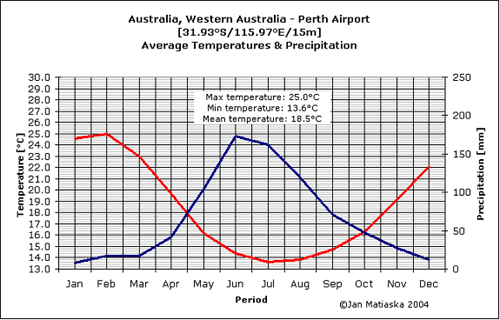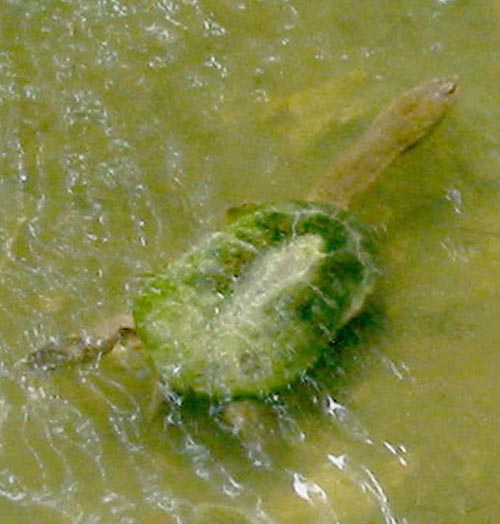

Oblong Turtle -- Chelodina oblonga
[4]

Diet
Like other members of the Chelodina genus, Chelodina oblonga is carnivorous feeding on aquatic insects, small fish, shrimp, yabbies, tadpoles and frogs. (Cann, 1998). Carrion is also eaten. There are about 55 inland fishes while the macro-invertebrate fauna of inland waters of the south-west consists of 250-300 taxa (Lane et al., 2001).
Invertebrates common in water of south-west include water flea (Daphnia carinata), the ostracod (Candonocypris novaezelandiae), the hemipterans (Micronecta robusta and Agraptocorixa hirtifrons) and the chironomids (Polypedilum nubifer and Kiefferulus intertinctus). (Davis et al., 1993)
Right figure: Average temperature and precipitation
In captivity, hatchlings feed on mosquito larvae, water fleas (Daphnia) and fish. (McCutcheon, 1985) Young turtles may also eat aquatic plants (McCutcheon, 1985). The species is able to catch live prey as it has the fastest strike out of all true Chelodina species. (Thomson, 2004, pers. comm.) Even though the species' body temperature was observed to vary between 18°C
and 31.0°C (Clay, 1981), it is recommended to keep the species in water
with the temperature of 22-23°C in order to maintain optimal consumption
and assimilation rates. Like many other Chelids, C. oblonga may increase
its rate of digestion by maintaining high body temperature through aquatic
basking in the warm top layer of the water. Apart from aquatic basking,
the species has been observed basking out of the water as well, resting
on woody debris that protrudes from the water surface.
Breeding
Mating occurs in winter and spring (the southern hemisphere time). According to Kuchling (1988) males sexually mature at the carapace length of 140mm while females mature at the length of 160-170mm.
Bottom photo: Chelodina oblonga in the wild
 Nesting occurs from September to January. According to Clay (1981), females begin to leave the water in search for a good nest site with the approach of a low pressure weather system promises some precipitation. When the female leaves the water she moves directly inland for a distance of 20 to 105 m and then begins looking for a nest site. Once the turtles have left the water, they are not easily disturbed. The turtles appear to choose sites that are open and free from thick vegetation for their nest sites. (Clay, 1981) Some nests have been found as far as 500m away from the nearest water body. The nest hole is 150-175mm deep and 37x50mm wide. (Burbidge, 1967) It takes about 15-25 minutes to dig up a nest. Females choose sandy soil as the optimal substrate. Depositing the eggs and filling up the nest may take up to 40 minutes. The actual nesting occurs in the afternoon or in the evening. Some females were observed to nest at night time. Two or three clutches are laid per season with 8-15 eggs in one clutch (Burbidge 1967, Clay 1981) and the maximum of 16 eggs recorded in one clutch. (Kuchling, 1988, 1989) Like many other Chelidae, C. oblonga female drops its shell hard onto the ground to compact the soil in the filled nest. (Clay, 1981)
Nesting occurs from September to January. According to Clay (1981), females begin to leave the water in search for a good nest site with the approach of a low pressure weather system promises some precipitation. When the female leaves the water she moves directly inland for a distance of 20 to 105 m and then begins looking for a nest site. Once the turtles have left the water, they are not easily disturbed. The turtles appear to choose sites that are open and free from thick vegetation for their nest sites. (Clay, 1981) Some nests have been found as far as 500m away from the nearest water body. The nest hole is 150-175mm deep and 37x50mm wide. (Burbidge, 1967) It takes about 15-25 minutes to dig up a nest. Females choose sandy soil as the optimal substrate. Depositing the eggs and filling up the nest may take up to 40 minutes. The actual nesting occurs in the afternoon or in the evening. Some females were observed to nest at night time. Two or three clutches are laid per season with 8-15 eggs in one clutch (Burbidge 1967, Clay 1981) and the maximum of 16 eggs recorded in one clutch. (Kuchling, 1988, 1989) Like many other Chelidae, C. oblonga female drops its shell hard onto the ground to compact the soil in the filled nest. (Clay, 1981)
Eggs size varies from 30x18mm to 35x22mm while the weight can be anywhere between 6.5 and 11.5g. The mean length and weight of hatchlings is 31mm and 9.5g respectively. (Kuchling, 1988, 1989) The incubation period lasts from 200 to 230 days under natural conditions (Kuchling, 1988, 1989), but McCutcheon (1985) claims it took 291 days to hatch for eggs in a natural nest.
Conservation
As part of their breeding cycle, female Oblong turtles
leave the lake each summer to lay their eggs in nearby areas. During this
time many of them are killed on the roads. In fact, road deaths and predation
are the major threat to the population of Chelodina oblonga. Contributing
factors to this are high roadside kerbs, which make it difficult for turtles
to leave the road, a lack of awareness of the movement of tortoises during
the breeding season, and the presence of feral predators such as the fox.
(Fox et al., 2004)
Strategies which have been implemented as a result of the previous management plan include the construction of ramps on the roadside kerbs and the erection of signs to warn drivers of the presence of turtles (Fox et al., 2004), however little success was achieved. A study by Giles (2001) suggested several methods of reducing turtle deaths but these proposals have failed to be transferred into reality.
Beside road deaths and predation, another threat can be seen in severely reducing natural habitat due to the draining or filling of their swamps for agriculture.